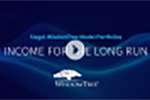By Brian Manby, CFA, Associate, Investment Strategy
- The current interest rate environment is negatively impacting U.S. small-cap equities, making it challenging for them to perform well compared to large caps.
- Small-cap investors are eagerly awaiting a policy rate pivot from the Fed, as this could potentially help small caps find traction and improve their performance.
- Incorporating a high-quality framework, such as the WisdomTree U.S. SmallCap Quality Dividend Growth Fund (DGRS), into small-cap allocations may help reduce volatility and potentially provide better returns in the face of rising interest rates.
As we conclude the first half of 2024, the “higher for longer” interest rate environment continues to stifle U.S. small-cap equities. While the S&P 500 relentlessly climbs higher, the Russell 2000 remains mired in a prolonged period of double-digit underperformance.
U.S Small-Cap Performance Worsens vs. Large Caps

Sources: WisdomTree, FTSE, S&P, as of 6/7/24. Past performance is not indicative of future results. You cannot
invest directly in an index.
Propelled by stellar earnings growth from the Magnificent 7 and positive momentum from artificial intelligence (AI) beneficiaries, large caps seem ostensibly unburdened. But small-cap fortunes are quite opposite, and daily market activity continues to reinforce that a higher rate regime is indeed an obstacle.
Over the long term, the outperformance of small caps over large caps has been uncorrelated with changes in interest rates, but recently these effects have been more pronounced. Since last summer, 60-day correlations between the excess returns of small over large caps and changes in the U.S. 2-Year Treasury yield (which is closely linked to monetary policy expectations) have been deeply negative, and the most negative since 1979. There are similarities in 252-day relationships, with today’s correlations the most negative in 40 years.1
Rolling Correlation: U.S. 2-Year Treasury Yield Changes vs. Small-over-Large Excess Return

Sources: WisdomTree, Federal Reserve Bank of St. Louis (FRED), FTSE Russell, as of 6/6/24.
Therefore, small-cap investors are eager for the Fed’s pivot to rate cuts, and rightfully so. My colleague, Andrew Okrongly, illustrated the recent relationship between small cap excess returns and the number of rate cuts expected by the end of 2024. As expectations for the number of rate cuts implied by Fed Funds Futures continue to dwindle, small caps continue to struggle relative to large caps. Furthermore, they may not gain traction until U.S. economic data weakens sufficiently to force the Fed into a policy pivot.
When Will Small Caps Gain Traction? Ask the Fed…
 Sources: WisdomTree, Bloomberg, as of 5/28/24. Historical period shown is 6/23/23–5/24/24. U.S. Small Caps vs. Large Caps represents the cumulative return of S&P 600 Total Return Index vs. S&P 500 Total Return Index over historical period. LHS = Left-hand side. RHS = Right-hand side. You cannot invest directly in an index. Past performance is not indicative of future results.
Sources: WisdomTree, Bloomberg, as of 5/28/24. Historical period shown is 6/23/23–5/24/24. U.S. Small Caps vs. Large Caps represents the cumulative return of S&P 600 Total Return Index vs. S&P 500 Total Return Index over historical period. LHS = Left-hand side. RHS = Right-hand side. You cannot invest directly in an index. Past performance is not indicative of future results.
The above charts illustrate the small cap interest rate obstacle from a macroeconomic perspective, which complements the more granular analysis about interest rate consequences for small caps we wrote about late last year. Many of these same challenges facing small caps remain intact today, particularly regarding balance sheets, debt burdens and rising interest costs.
S&P Indexes Cost of Debt

Sources: WisdomTree, FactSet, S&P, as of 5/31/24. You cannot invest directly in an index. Cost of Debt calculated as the trailing 12-month interest expense divided
by total debt.
For definitions of terms in the graph above, please visit the glossary.
Even the S&P SmallCap 600 index, which is a higher quality subset of the U.S. small-cap market compared to the Russell 2000, is now burdened with the highest interest costs on debt in a decade. This is unique to smaller companies as the increase in interest costs diminishes further up the size spectrum. Once again, the modest increase in S&P 500 interest costs suggests that U.S. large caps seem relatively unimpacted by higher rates.
S&P Indexes Interest Coverage

Sources: WisdomTree, FactSet, S&P, as of 5/31/24. You cannot invest directly in an index. Interest Coverage Ratio = trailing 12-month (TTM) earnings before interest and taxes (EBIT) divided by TTM interest expense.
Rising interest costs are becoming an even greater concern, however, because they’re unaccompanied by equal growth in operating earnings to service them. Interest coverage ratios across the size spectrum are in precipitous decline and small caps are in a precarious position.
Today, they only have operating earnings sufficient to cover their debt costs twice over. Mid-caps, using the S&P MidCap 400 Index, have also suffered but still have about four times their interest expenses available, in line with the historical median. Meanwhile, large caps still have about eight times their debt service costs available, which is still much higher than the historical median despite falling from double-digit territory.
An Actionable High-Quality Small-Cap Idea
The above charts punctuate the importance of owning a subset of small caps with the greatest potential to withstand the burden of higher rates through improved profitability. We call these quality companies, and they may even outperform the broader market and mitigate volatility over the long term.
Based on portfolio returns from the Kenneth French Data Library, we find that quality companies (with high operating profitability, by French’s definition) has been one of the most successful factors to pair with small caps over the past 50 years from both a performance and volatility perspective.
A high-quality small-cap portfolio outperformed generic small-cap ownership over 94% of the time when examining rolling 10-year returns, with about 5.4% volatility.
The performance and volatility tandem trails the low volatility factor, but the past few years suggest this may be changing. Low volatility has been the worst performing factor among small caps in the post-pandemic environment, while quality has led with relatively uninterrupted upside. Since March 2020, quality has delivered the best risk-adjusted returns among small-cap factor pairs.
 Sources for graph and table: WisdomTree, Kenneth French Data Library. Using monthly data as of 3/31/24, which is the latest available, to calculate rolling 10-year annualized returns. Value: Small High Book-to-Market portfolio. Quality: Small High Operating Profitability portfolio. Low Vol: Small Low Variance portfolio. High Div: Small High Dividend Yield portfolio. Market: lowest 30% of all CRSP® firms by market value incorporated in the U.S. and listed on the NYSE, AMEX or NASDAQ. Past performance is not indicative of future results.
Sources for graph and table: WisdomTree, Kenneth French Data Library. Using monthly data as of 3/31/24, which is the latest available, to calculate rolling 10-year annualized returns. Value: Small High Book-to-Market portfolio. Quality: Small High Operating Profitability portfolio. Low Vol: Small Low Variance portfolio. High Div: Small High Dividend Yield portfolio. Market: lowest 30% of all CRSP® firms by market value incorporated in the U.S. and listed on the NYSE, AMEX or NASDAQ. Past performance is not indicative of future results.
WisdomTree believes in this unison and combines the quality and size factors within our flagship quality dividend growth methodology. Launched in 2013, the WisdomTree U.S. SmallCap Quality Dividend Growth Fund (DGRS) has nearly 11 years of history and outperformance over the Russell 2000 and Russell 2000 Value indexes over the trailing 1-, 3-, 5-, 10-year and since-inception periods.2
The combination of static and trend-based observations of return on equity (ROE) and return on assets (ROA), coupled with earnings growth estimates, gives its stock basket an explicit focus on profitability in a market environment where robust and profitable operations are exactly needed to combat interest rate obstacles.
This is evident in its fundamentals as well. DGRS improves upon virtually every important measure of quality compared to the Russell and S&P small-cap indexes at much lower P/E multiples.
This is significant because we typically expect high-quality allocations to trade at a valuation premium to lower quality ones, but the U.S. small-cap indexes are full of so many companies with little-to-no profitability that their multiples are skewed wildly higher. DGRS’s stock basket offers more profitable exposure at a deep valuation discount to the broader market.
The ROE and ROA measures alone illustrate how the quality methodology condenses the junky small-cap market with limited profitability into one more capable of withstanding an economic downturn.
 Sources: WisdomTree, FactSet, as of 5/31/24. You cannot invest directly in an index. Performance data quoted represents past performance and is no guarantee of future results. Investment return and principal value of an investment will fluctuate so that an investor’s shares, when redeemed, may be worth more or less than their original cost. Current performance may be lower or higher than the performance data quoted.
Sources: WisdomTree, FactSet, as of 5/31/24. You cannot invest directly in an index. Performance data quoted represents past performance and is no guarantee of future results. Investment return and principal value of an investment will fluctuate so that an investor’s shares, when redeemed, may be worth more or less than their original cost. Current performance may be lower or higher than the performance data quoted.
For DGRS’s full standardized and most recent month-end performance, please click here.
It even beats some of the metrics of the innately high-quality S&P SmallCap 600 Index, where the joint pickup in ROE and ROA result in reduced leverage that may mitigate the rising interest expenses afflicting the broader market.
Preparing for a Policy Pivot
Although the prevailing interest rate environment presents challenges for U.S. small caps, there may be a silver lining in the interim in higher-quality allocations that could be more insulated from the effects of higher rates.
Likewise, if current relationships hold, the shift could turn interest rate headwinds into a long overdue tailwind to help small caps finally find traction once the Fed eventually pivots. Layering a high-quality framework into small-cap allocations may help reduce volatility along the way so that potential gains may not be eroded as quickly as they’re earned.
We think DGRS is well positioned in this environment and should be considered for small-cap investors looking ahead to an eventual policy rate pivot from the Fed, and as a longer-term holding period thereafter.
1 Sources: WisdomTree, Federal Reserve Bank of St. Louis (FRED), FTSE Russell, as of 6/6/24.
This article originally appeared on WisdomTree’s website and is reprinted on VettaFi | ETF Trends with permission from the author. For more information, please visit WisdomTree.com.
Important Risks Related to this Article
There are risks associated with investing, including the possible loss of principal. Funds focusing their investments on certain sectors and/or smaller companies increase their vulnerability to any single economic or regulatory development. This may result in greater share price volatility. Dividends are not guaranteed, and a company currently paying dividends may cease paying dividends at any time. Please read the Fund’s prospectus for specific details regarding the Fund’s risk profile.







